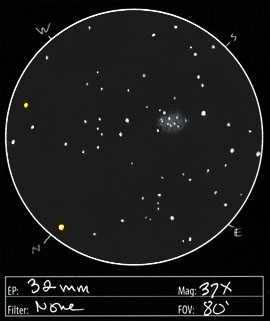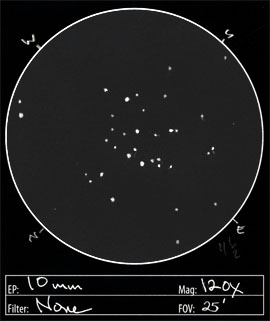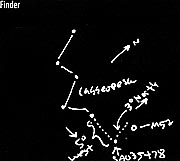

Observation Notes:
 A storm had blown out earlier in the afternoon, and bursts of spontaneously condensing rain were blowing overhead at odd intervals. But I wanted to see these northern clusters before they dissappeared for the season. So I clothed the scope in towels over the eyepiece, aperture, and electronics during the spritzings and pressed on with the observations during the respites.
A storm had blown out earlier in the afternoon, and bursts of spontaneously condensing rain were blowing overhead at odd intervals. But I wanted to see these northern clusters before they dissappeared for the season. So I clothed the scope in towels over the eyepiece, aperture, and electronics during the spritzings and pressed on with the observations during the respites.
It took some deliberate planning, star-hopping, and angle counting to find M52. There are so many other clusters in this area. I swept 5 degrees west from Caph in Cassiopeia until running into a bright Mag. 4.8 star (SAO 35478). Then I went 3 degrees north and then scanned just a bit west to find it.
M52 didn’t pop out as easily as some of the other recent clusters I’ve viewed. It gave off a soft glow that started to show granularity behind the brighter stars. It seemed to be elongated a bit northwest to southeast. There was a bright star anchoring the cluster right on the west-southwest end. I made the 37X sketch with the cluster off to one side to include a bright orange star exactly to the north, about 45′ away. The width of the cluster appeared to be 8′ in the 120X view. There was a loose question mark asterism formed by the brighter stars. At 120X, faint, unplottable stars were popping in and out of the rough seeing conditions. During the 37X sketch, a satellite passed very slowly southwest to northeast along the northwest edge of the view.
Factoids:
M52 is a rich open cluster with 193 probable members within a 9′ radius. The distance to the cluster is not well known, with estimates ranging from 3000 to 7000 light years. The reason for this is the relatively high amount of interstellar absorption between us and the cluster. If one assumes a distance of 5000 light years, the cluster’s diameter works out to 19 light years. The cluster was discovered by Charles Messier in 1774.
| Subject | M52 (NGC 7654) |
| Classification | Open Cluster |
| Position* | Cassiopeia [RA: 23:24.2 / Dec: +61:35] |
| Size* | 13′ |
| Brightness* | 7.3 |
| Date/Time | February 12, 2005 – 10:30 PM (February 13, 2005 – 05:30 UT) |
| Observing Loc. | Flagstaff, AZ – Home |
| Instrument | Orion SVP 6LT Reflector (150 mm dia./1200 mm F/L) |
| Eyepieces/Mag. | 32 mm (37X), 10 mm (120X) |
| Conditions | Partly Cloudy, 36°F, occasional mist of rain |
| Seeing | 1-2/10 |
| Transparency | Mag 5.8 |
| Sources | SEDS |
*Based on published data.
Sketch of M52 at 37X
Sketch of M52 at 120X
Observation Notes:
Finder Sketch of M52
A storm had blown out earlier in the afternoon, and bursts of spontaneously condensing rain were blowing overhead at odd intervals. But I wanted to see these northern clusters before they dissappeared for the season. So I clothed the scope in towels over the eyepiece, aperture, and electronics during the spritzings and pressed on with the observations during the respites.
It took some deliberate planning, star-hopping, and angle counting to find M52. There are so many other clusters in this area. I swept 5 degrees west from Caph in Cassiopeia until running into a bright Mag. 4.8 star (SAO 35478). Then I went 3 degrees north and then scanned just a bit west to find it.
M52 didn’t pop out as easily as some of the other recent clusters I’ve viewed. It gave off a soft glow that started to show granularity behind the brighter stars. It seemed to be elongated a bit northwest to southeast. There was a bright star anchoring the cluster right on the west-southwest end. I made the 37X sketch with the cluster off to one side to include a bright orange star exactly to the north, about 45′ away. The width of the cluster appeared to be 8′ in the 120X view. There was a loose question mark asterism formed by the brighter stars. At 120X, faint, unplottable stars were popping in and out of the rough seeing conditions. During the 37X sketch, a satellite passed very slowly southwest to northeast along the northwest edge of the view.
Factoids:
M52 is a rich open cluster with 193 probable members within a 9′ radius. The distance to the cluster is not well known, with estimates ranging from 3000 to 7000 light years. The reason for this is the relatively high amount of interstellar absorption between us and the cluster. If one assumes a distance of 5000 light years, the cluster’s diameter works out to 19 light years. The cluster was discovered by Charles Messier in 1774.
| Subject | M52 (NGC 7654) |
| Classification | Open Cluster |
| Position* | Cassiopeia [RA: 23:24.2 / Dec: +61:35] |
| Size* | 13′ |
| Brightness* | 7.3 |
| Date/Time | February 12, 2005 – 10:30 PM (February 13, 2005 – 05:30 UT) |
| Observing Loc. | Flagstaff, AZ – Home |
| Instrument | Orion SVP 6LT Reflector (150 mm dia./1200 mm F/L) |
| Eyepieces/Mag. | 32 mm (37X), 10 mm (120X) |
| Conditions | Partly Cloudy, 36°F, occasional mist of rain |
| Seeing | 1-2/10 |
| Transparency | Mag 5.8 |
| Sources | SEDS |
*Based on published data.